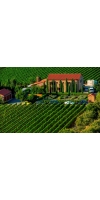Wine from Alloro Vineyard

The Alloro Estate
Alloro Vineyard is 78 acres of uniquely contoured, loess-derived, Laurelwood soil. Located on a southwest-facing slope in Oregon’s Chehalem Mountains AVA, within the Willamette Valley, this very special place is the heart and soul of our wines and is personally cared for by Founder, David Nemarnik. We are an artisan, limited-production producer and are 100% Estate, crafting all our wines from this single vineyard. Our Burgundy trained, UC Davis educated Winemaker, Tom Fitzpatrick, is focused on producing elegant wines of balance, with character and soul, that capture the distinct personality of our terrior, the purity of its fruit, and that delight and inspire.
The winery was designed specifically for the production of small lots of handcrafted Pinot noir. The building is situated at the crest of the hill, in the center of our estate vineyard. Having the winery in the middle of the estate allows us to be intimately connected to what is happening with the vines during the growing season, and allows for very close monitoring of fruit ripeness and optimal harvest timing.
The building was designed and engineered to last for generations, constructed almost entirely out of concrete and Oregon Douglas fir. The traditional underground cellaring caves are energy efficient, taking advantage of the cool earth to maintain ideal cellaring temperature and humidity. Solar panels were installed to act as the primary source of energy for winery operations. The winery was designed by Architect Larry Ferrar and was completed in time for the 2003 harvest.
Alloro, Italian for laurel, is the evergreen plant said to symbolize immortality in ancient times and often used as a symbol for peace today. Our estate vineyard and winery are located on Laurel Ridge in the Chehalem Mountains and the vineyard’s ancient basalt and loess soil is of Laurelwood Series. Alloro was chosen to reflect our founder’s Italian heritage and as a symbol of this very special place.
The Alloro Vineyard
78 acres of uniquely contoured, loess-derived, Laurelwood soil. Located on a southwest-facing slope in Oregon’s Chehalem Mountains, this special place is the heart and soul of our wines.
Our Chardonnay blocks are comprised of Dijon clones 76 and 96, grafted to Riparia Gloire rootstock.
Our Pinot noir blocks are comprised of clones 777, 667, 114, and Pommard, grafted to Riparia Gloire and 3309 root stocks.
No products found
- back
Selected Options
Wineries
Categories
Pricing
Countries
Regions
Grape Types
Wineries
Organic/Free Shipping
Domaine Louis Moreau Chablis Vaillons Premier Cru is made from 100 percent Chardonnay.
Chablis achieves its highly distinctive mineral character due to its cool northerly climate and its highly calcareous soil. The Domaine Louis Moreau Chablis Vaillons Premier Cru is a generous, fleshy and lively wine that displays a beautiful balance of minerality, fruitiness and elegance.
Chablis, with its steely character and fresh citrus flavor, pairs well with white fish and shellfish and its naturally high acidity can counterbalance cream-based sauces. Unoaked Chablis lends itself well to vegetables, starches, Comté, or fresh goat cheese.
Ferren Pinot Noir Sonoma Coast is made from 100 percent Pinot Noir.
100% native fermentation (primary and secondary), long cool fermentations often lasting up to a full year, minimal lees stirring, no additions of any kind (commercial yeast, water, acid, enzymes, etc., never any fining or filtration). Aged 18 months in 15% new French oak (Francois Freres, Vosges, Troncais Forrests)
Review:
A lovely and balanced wine that is pleasurable and complex. Spices, cherries, dried cranberries, mixed berries, bramble fruit, black truffles and forest floor. Salty minerality and orange zest in the finish. Medium body. Drink now.
-James Suckling 94 Points




